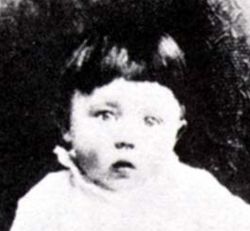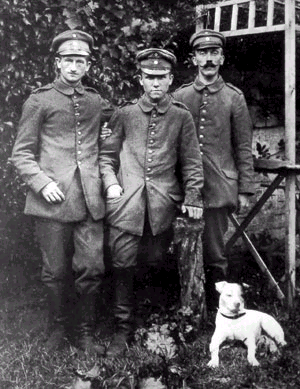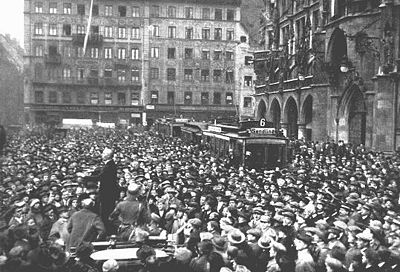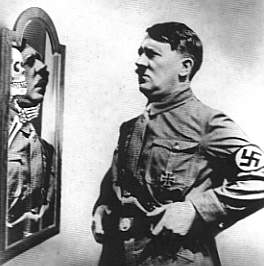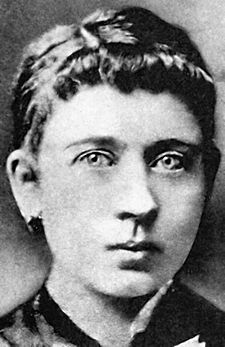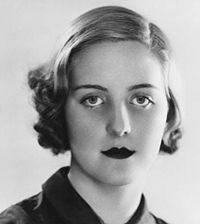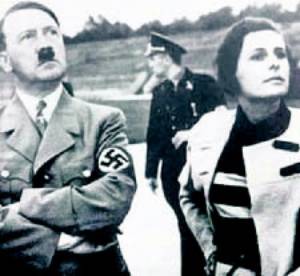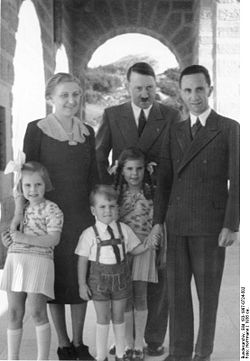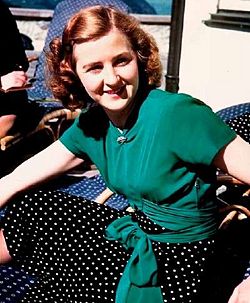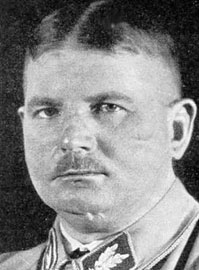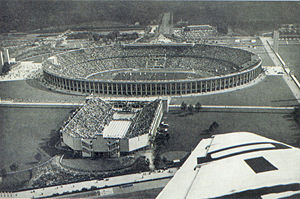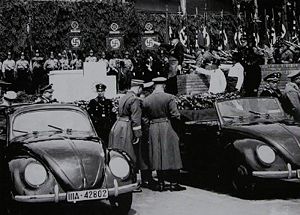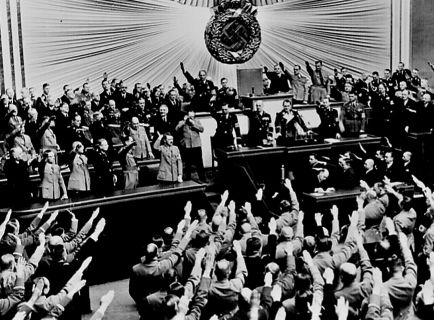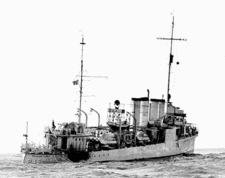Adolf Hitler
This article focuses on the personal actions and thoughts of Hitler himself. See National Socialism (or Nazi Party) for the development of the movement and eventually the government.
Adolf Hitler (1889-1945), the leading figure of National Socialism and Nazi dictator of Germany (1933-45), was a dominant world figure before and during World War II. As a leader, he differed from the other great dictator of the time, Joseph Stalin, in that his authority was based on charisma rather than ideology. [1] In other words, Nazi ideology was what Hitler believed. Like Stalin, Hitler deliberately gave overlapping responsibilities to subordinates, keeping them from growing too powerful and making him the ultimate authority. In particular, the same function could be assigned both to the government of the State and the Nazi Party. Complicating this was the rise of the Schutzstaffel (SS), fanatically loyal to Hitler, as a state-within-a-state.
As a youth, he felt he had a destiny, although originally as an artist. After failing to be admitted to art school, he went through a rootless period in Vienna, which probably first contributed to his obsessions about racial enemies; loosely, his ideas of a special Germanic race had developed along with his early love of Wagnerian and other heroic music. By the time he served in the First World War, bravely by many accounts, he had focused his hatred against the Jews. After World War I, his anger was increased by what was considered the "stab in the back" and the Treaty of Versailles. He began formal political activity in 1919, quickly discovered his ability as an orator, but did not really focus his political goals until the mid-1920s.
From a base in the Nazi Party, he maneuvered in various German coalitions, until the Nazis, through essentially democratic means, took control in 1933. They quickly moved to cut off democratic challenges, bloodily purge their internal opposition in the Night of the Long Knives, and increasingly emphasize their Nazi race and biological ideology as well as seeking Lebensraum, or room into which the racially pure could expand.
He became the dominant force in Europe and, after generally nonviolent occupations in Austria and Czechoslovakia, invaded Poland in 1939, as a violent example of the Drang nach Osten, the historical German demand for land in the East.[2] Poland started open war on the continent and spilling to Africa and the high seas. As well as foreign wars, he conducted The Holocaust within the areas under his powers, killing millions of Jews, Slavs, and others he considered undesirable. Eventually, an Allied coalition would force him back until he controlled but his bunker, where he committed suicide in 1945.
Historiography
Beginning with Konrad Heiden, biographers , began studying Hitler during his life. His book, published in 1936, ended in the summer of 1934.[3] After his death, an early and specialized work was Hugh Trevor-Roper's The Last Days of Hitler (1947).[4]
A great many works have tried to explain Hitler, with varying perspectives and conclusions. Indeed, Ron Rosenbaum collected and annotated a number of essays in his book Explaining Hitler.[5] Lothar Machtan, in the Hidden Hitler, which focuses on Hitler's sexuality and relationships, presents a model of Hitler historiography. [6] Perhaps the first major biography was Alan Bullock's 1952 Hitler: A Study in Tyranny. That was among the first to deal with Hitler's sexuality, although there had been a classified wartime study of his psyche, with substantial attention to sexuality, done by psychiatrist William Langer for the U.S. Office of Strategic Services. Bullock, to some extent, revised some observations, but not their core, in a 1991 biography Hitler and Stalin: Parallel Lives. While a general history of Nazi Germany, William Shirer's 1959 Rise and Fall of the Third Reich provides much information. It discusses both Hitler and his close associates.
Another major work, among the first published in German, was Joachim Fest's 1972 book, Hitler. By the 1970s, there were two main schools of Hitler biography: the functionalists and the intentionalists. Functionalists saw Hitler as motivated by the exercise of power regardless of purpose, while the intentionalists focused on his specific vision.
According to Machter, Hans Mommsen was the leader of the functionalists. He considered Hitler a "political counterfeiter" who succeeded because he was constantly overrated, extremely effective with propaganda but not in performance. [7] Machter considers Ian Kershaw to be the leading current historian, attempting to unify the two schools.
Early Life to 1919
Hitler was born in Braunau, Austria-Hungary to a devout Catholic family of middle class status. Little is known of his ancestry. His father, Alois, was the illegitimate son of a servant girl, Marianne Schickelgruber in Graz. In 1876 Alois legally changed his name to Alois Hitler. Since this was before Adolf's birth, the claim that his name really was Adolf Schickelgruber cannot be true.
Youth
Akois was a minor official of the Imperial Austrian customs service, a prestigious white collar position. Alois was widowed twice, and died in 1903.
His third wife, Klara Poelzl Hitler — who was 23 years his junior — bore him six children, only two of whom reached maturity: Adolf, and his younger sister Paula, who died in 1960. After the dealt of Alois, she moved to a more modest apartment, living on savings and pension. She tried to educate him in accordance with his father's intention, explained by Adolf as "to have me study for a civil servant's career."[8]
A mediocre student, he dropped out at age 16, as was normal for someone not headed to university.[9] This was facilitated by a long illness, which required him to drop out of school for a year. [8] While he called the years between 16 and 19 the happiest of his life, he both rejected a trade and wanted to become an artist, and was concerned with politics. His boyhood friend, August Kubizek, said "he saw everywhere only obstacles and hostility....He was always up against something and at odds with the world...I never saw him take anything lightly." While he rejected formal education, Kubizek said he was always surrounded by books, especially on German history and mythology. [10]
Georg Ritter von Schoenerer had been instrumental, in the 1870s, of introducing "raucous nationalism" to parliament. von Schoenerer's ideology was centered on antisemitism, and extended to anti-liberalism, anti-socialism, anti-Catholicism, and opposition to the Hapsburgs. Hitler had already absorbed ideas from him while at home in Linz, including the "Heil" greeting and the term "Fuehrer", applied to von Schoenerer. [11] von Schoenerer was also sexually puritanical, preaching celibacy until the age of 25, keeping the race pure by avoiding infection from prostitutes. [12]
The music of Richard Wagner influenced him at age 17, both in terms of heroic agendas and antisemitism. He later wrote that "whoever who wants to understand National Socialism must know Wagner."[13]
First stay in Vienna
Intending to study fine arts, he moved to Vienna in 1907, but failed the entrance examinations both for the Vienna Academy of Fine Arts. While the art school suggested his talent might be more in architecture, his failure to graduate from high school barred the School of Architecture from him. It was possible to apply for a waiver, but, as far as is known, he never did so.
The academic counselor for architecture said he needed more experience, but some of his work was interesting. Hitler would continue a lifelong interest in architecture, [14] generally believed to be the core of his friendship with Albert Speer.
By the time Hitler arrived, the influence of von Schoenerer, who had never tried to build a mass party, was in decline. Hitler questioned his willingness to participate in parliament, and thus began to be influenced by Karl Lueger, the "tribune of he people". Lueger was also strongly antisemitic, but less ideologically than von Schoenerer: he would say "I say who a Jew is". Still, Lueger was appointed Lord Mayor of Vienna in 1897, who built the Catholic Christian Social Party. While antisemitic, he was pro-Habsburg, populist, and scial reformer. Hitler did not learn ideology from him, but manipulating the mob.[15]
Mother's illness
Kubizek and Klara did not hear from Adolf after she first moved to Vienna. She disapproved of his withdrawing his inheritance to study, and she said she had become an "old, sick woman."[16]
She developed breast cancer in 1907, and was treated by Dr. Edward Bloch, a Jewish physician to whom Hitler paid much respect and to whom he would send greetings later in life. After heroic but unsuccessful treatment, she died in 1908. The surgical wound had been treated locally with strong-smelling iodoform, which left a lifelong impression. He returned from Vienna to care for her in her last days, during which she was to whisper to Kubizek, "Gustl, go on being a good friend to my son when I'm no longer here. He has no one else."
Return to Vienna
He spent the next four unhappy years in Vienna, largely in poverty and hunger. Kubizek mentions him as surrounded by books, but only slecifically remembers Legends of Gods and Heroes: the Treasures of Germanic Mythology. [17] Perhaps the authoritative reference is J. Sydney Jones' Hitler in Vienna, 1907-1913[18] By August 1909, he was homeless, living on the streets and in the most impersonal of shelters. [19] In February 1910, he was able to move to a dormitory that offered some individuality. Guided by a friend he met there, Reinhold Hanisch, he was guided into a beginning of self-respect, after receiving funds from his sister.[20] While taking part in political arguments at the dormitory, Hanisch said "When he got excited, Hitler couldn't restrain himself. He screamed and fidgeted with his hands. But when he was quiet, he seemed to have a fair amount of self-control and acted in quite a dignified manner." Hanisch remembered only one anti-Semitic comment, and that Hitler spoke of gratitude to Jewish charities, admiration for Jewish resistance to persecution; his friend believes his strong for Jews, which he claims, in Mein Kampf, formed in Vienna, developed later. [21]
He took to observing the Parliament, and, according to Heinz, was shocked by the disorder; this led to his antiparliamentary beliefs. [22] Kershaw speculates that his reading included the racist and somewhat occult magazine, Ostara, which focused on "homoerotic notions of a manichaean strggle between the heroic and creative 'blond' race and a race of predator dark 'beast-men' who preyed on the 'blond' women with nimal lust and bestial instincts that were corrupting and destroying mankind and it culture.' The author was a former monk, Joerg Lanz von Liebefels, who formed the "New Templar Order" in a ruined culture. [23]
Continuing his art and selling some of his work, by 1912, according to Shirer, he was a competent draftsman, producing acceptable architectural work in pencil, oils, and watercolor, but having great difficulty in drawing realistic human figures. Hanisch sold his work, and the other partner was a Jew, Joseph Neumann, with whom he was friendly enough to visit museums. [24]e
Munich
Hitler moved to Munich in 1912, renting a room with a Frau Popp, and signing the register as an architectural painter. He had a warm relationship with the Popp family, welcoming Frau Popp as a visitor after he became Chancellor. [25]
World War I
While he had formed antisemitic views in Vienna, his beliefs, which would lead to The Holocaust, intensified during the war. Fellow soldiers, in the trenches, would recount how he would constantly complained of the "invisible foes", the Jews and Marxists. They generally regarded him as strange and distant, which would not help him in potential troop command. [26] Some of his comrades, however, would stay lifelong associates, such as Max Ammann, his sergeant and company clerk, who would become the early Nazi Party treasurer, and then take the lucrative position of publisher for the Party. At the front, his personal reading material consisted of an architectural guides to Berlin, by a Jewish architectural critic, Max Osborn.[27]
He was a brave if unconventional soldier, being decorated with the Iron Cross Second and First Class, the latter unusual for a junior enlisted man. It was recommended by his immediate superior, Lieutenant Hugo Gutmann, a Jew. His officers considered him thoroughly reliable in carrying out tasks as a combat messenger, but did not promote him because they did not feel he was capable of command. Hitler only began to wear the Iron Cross in 1927, as he became active in politics. He did help Guttman emigrate in 1939 and issued him a pension that would last to the end of the war, but, in 1941, said of him
I did not wear the Iron Cross 1st class during the World War [1914-18] because I saw how it was awarded. We had a Jew in the regiment, Gutmann, an unparallelled cowardly person. He wore the Iron Cross 1st Class. It was revolting and a disgrace. [28]
In 1916 and 1917, recovering from combat wounds in Munich, he observed "I thought I could no longer recognize the city", and became furious about the "Hebrew corruptors of the people". [29]
Political beginnings
In September 1919 Adolf Hitler joined the DAP. Hitler, who had finished the war in a military hospital after suffering a poison gas attack at the front, had returned to Munich in November 1918. After the war he remained in the army and had joined the intelligence section. In this capacity he was sent to monitor the DAP’s activities. He found the DAP reflected his own views – German nationalism, anti-liberalism, anti-Semitism. He became the party’s 55th member.
Dietrich Eckhart first attracted him intellectually in the party, and mentored him. He was to meet Houston Stewart Chamberlain in 1923, who influenced much of his thinking.
By 1924, certain elements of Hitler's worldview (Weltanschauung) had fully crystallized, namely his concept of history as a racial struggle and the threat of Marxism. He considered Communism to be a Jewish conspiracy, and often referred to "Jewish-Bolshevik Commissars"; the Commissar Order for the Russian Front was an even more certain death sentence for Communist leaders than for Jews.
The key element in Hitler's success in 1932-33 was the decision of powerful non-Nazi conservative nationalists to support his selection as chancellor, since the Nazis did not have a majority in the Reichstag.
A rally too far
Political tensions had been rising, both in the Weimar Republic generally and in Bavaria specifically, in 1922 and 1923. Hitler was sentenced to three months' imprisonment in 1922, of which he served four weeks for an incident in which he led Nazis to disrupt a meeting or the Bavarian League and beating its leader. He was carried to the podium on hs first public appearance after release. The local police, previously headed by a Nazi sympathizer, but now by Eduard Nortz, banned a rally in early 1923.
Roehm and von Epp met with General Gustav von Lossow, the Reichwehr commander in Bavaria. The military commander, although dubious about Hitler's personality, said he would consider "the suppression of teh nationalist organizations unfortunate for security reasons", Nortz requested the NDSAP to reduce the number of rallies, but Hitler, seeming to agree, ignored it. [30]
The Army, generally, had been marginal in its compliance with the Weimar Republic. It was not clearly subordinate to the Reichstag and the Cabinet. The French occupied the Ruhr in January 1923, and hyperinflation had begun. Hitler saw this as a time of opportunity. [31]
On November 8, Hitler and the Nazis, significantly without giving General Eric Ludendorff an opportunity to coordinate with them, sent a large force into a meeting, at a beer hall used for assemblies, being addressed by Gustav von Kahr, Prime Minister of Bavaria, who, with Army commander von Lossow and state police chief Hans von Seisser, ruled Bavaria. The three made promises, under duress, to Hitler, but quickly left.
The next day, Hitler and Ludendorff led a march on the War Ministry, here Ernst Rohm had been held. It is unclear which side fired first, but sixteen Nazis and three police died. Ludendorff was arrested on the scene, while the wounded Hitler and other Nazis escaped.
The Nazis involved were put on treason on 25 February 1924. Hitler was sentenced to five years imprisonment, which he spent, in comfort, in Landsberg Prison, along with associates. He wrote Mein Kampf during that time, and was released after serving nine months.
Mein Kampf
Hitler wrote his autobiographical Mein Kampf ("My Struggle") while imprisoned after the Beer Hall Putsch; its two volumes were published in 1925 and 1926. He dictated it to Rudolf Hess. Although most critics believe it desperately required editing, Father Bernhard Stempfle did help in this area.
Hitler recounts his personal and intellectual development from childhood to adulthood, including his home life, his student aspirations as an artist, his experience as a soldier on the battlefield, and his evolving political philosophy. Then he lays out the political program of the Nazi movement both theoretically and in terms of German history and the German sociopolitical situation of 1925. Hitler states his goal to realize the German nation's destiny by uniting all Germans geographically and politically into one Reich that is rid of all non-German elements. Geographically he envisions a German homeland stretching out into eastern Europe. For Hitler, the German nation -- the volkisch nation -- comprises only those of pure German blood. The race of Slavs naturally competes with and impinges on the German nation, threatening and constraining its development; Hitler, however, designates the Jews as a singularly vile and cultureless race bent on world destruction through Communism. They will eventually self-destruct, he says.
Party organization
While Hitler worked on the second volume of Mein Kampf in early 1935, after a public speaking ban was put into effect, he sent Gregor Strasser to organize the party in Northern Germany.[32]
Development of views and propaganda
However, the notion of Lebensraum (living space) and the idea of a heroic Führer, underdeveloped in 1924, became fully crystallized by 1928. Hitler offered only "distant goals" not a "blueprint for rule." There is scant evidence to support the notion that he was a conscious modernizer; his goal was to destroy Marxism and re-create the Volksgemeinschaft (folk community) that supposedly existed in the past. This community concept was the basis for much propaganda, but "But propaganda alone could not have sustained the Nazi Party and its ideology over a period of 12 years. There is now considerable evidence to suggest that nazi policies and propaganda reflected many of the aspirations of large sections of the population." [33]
Hitler had been a natural orator with small groups, but Hanfstaengl and others coached him in improving his delivery; the rare photograph shows him practicing.
Personal life
In attempting to explain Hitler's motivation, many historians and social scientists have looked at his personal relationships. They agreed the relationships often were abnormal, but there is no consensus either on how they affected him or what his true sexuality may have been. Kershaw, drawing in part from Kubizek, suggests he was prudish and offended by sexuality of all types, which could well have been based on von Schenerer's principles. He met with "cold indifference" flirtation from young women, was repelled by homosexuality, refrained from masturbation, and was horrified but fascinated by prostitution. [34] He was terrified by venereal disease, a theme that recurred in Mein Kampf.
Relationship with women
While he did not follow her desires for him to learn a trade or further his education, Hitler was extremely close to his mother, Klara. Her physician told Hitler her "death had been a savior" from her pain, but said "In all my career, I never saw anyone so prostrate with grief as Adolf Hitler." [35]
He appeared to enjoy the company of attractive women, but was awkward in starting relationships. Of the women to whom he was close, Eva Braun and Geli Rabaul committed suicide, while Unity Mitford and Mimi Reiter attempted it. There was "gossip" he had relationships with Leni Riefenstahl and actresses Olga Tscechowa, Lil Dagover and Pola Negri. Shirer observed that he sought the "stimulation his suppressed bohemian nature craved," rather than sex. [36]
Unity Mitford, the British daughter of Lord Redesdale, was an art student in Germany, who became a Nazi as soon as she met Hitler. Different than other women he knew, she was extremely free in his speech, quite blunt to him at times. [36]
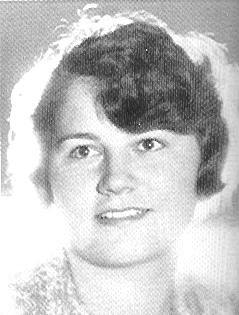
Geli Rabaul
His niece, Geli was his great love, although it is not at all clear that the intensity was reciprocal. They probably first met in the summer of 1924, when Angela Raubal visited her half-brother Adolf, bringing 16-year-old Geli. She graduated from high school in 1927, and visited him on a school trip; he later took her, along with her mother and a girlfriend, on a road trip. Rudolf Hess called her a "tall, pretty girl of nineteen...always cheerful and as little at a loss as her uncle...the latter is hardly a match for her ready tongue." [37]
Alan Bullock wrote "This period in Munich Hitler later described as the happiest in his life; he idolised this girl, who was twenty years younger than himself, took her with him whenever he could - in short, he fell in love with her...She was flattered and impressed by her now famous uncle, she enjoyed going about with him, but she suffered from his hypersensitive jealousy."
She was to die, under questionable circumstances, in September 1931. It is most often considered a suicide by gunshot. Hitler himself was far away and could not have killed her, but it has been suggested by some that he ordered her death.
Contrasting her to Eva Braun, he told his secretary, Christa Schroeder, "Eva is very nice, but in my life, ony Geli could have inspired in me genuine passion. I can never think of marrying Eva.The only woman I could have tied myself to for life was Geli."[38]
Leni Riefenstahl
With other, stronger women, such as Leni Riefenstahl, he kept a distance. Riefenstahl, a distinguished cinematographer, actress and photographer, had a far stronger personality than Braun or Raubal. The two were taking a leisurely seaside walk in May 1932, which she describes as
Quite relaxed, Hitler spoke of his private life and of things that particularly interested him. Foremost among them were architecture and music — he spoke of Wagner, King Ludwig, and Bayreuth. After he had talked of them for a while, his expression and voice suddenly changed. Fervently, he said "But what fulfills me more than anything else is my political mission. I feel it is my vocation to save Germany — I cannot and may not evade it"...It was dark, and I could no longer see the men behind us. After a long pause he came to a halt, gave me a lingering look, slowly put his arms around me, and drew me to him....He looked at me excitedly When he saw how averse I was he at once let go of me. He turned away a little. Then I saw him raise his hands and say imploringly, "I cannot love any women until I have completed my task."[39]
Magda Goebbels
Women, such as Magda Quandt Goebbels, would also fixate on him, and she chose to die with him, killing her children. While working as Goebbels' secretary (and lover) in the fall of 1931, she called on Hitler, and both experienced strong emotions. She would tell Riefenstahl that she was in love with him, but, "It was not until I realized that, discounting his niece Geli,Hitler cannot love any woman, but only, as he always says, 'his Germany', that I consented to marry Dr. Goebbels, because now I can be near the Fuehrer." After the marriage, she said "We like to think of this [i.e., our] apartmen t as his second home. Hitler now had the "devotion, admration and solicitude of a charming woman without having to commit himself in any way." He could use Geli's death to say he had "overcome the urge to overcome a woman physically."[40]
Eva Braun
Eva Braun was his longest adult relationship. An assistant to his photograper, Hans Hoffman, he saw both Eva and Geli in the same time period, contributing to Geli's tensions.
They finally married just before their joint suicide in Hitler's bunker. Prior to that, she had long been his companion, but known only to his personal staff. After Hitler once made a public statement that he had no private life, she quipped "just call me Miss No Private Life."
Relationships with men
In his youth, he was very close, in both his home and in Vienna, with a peer, August Kubizek.
When he joined the early party, he became very close to Ernst Roehm, who was the only person with whom he was on a first-name basis, and was a "Duzfreund" -- a friend with whom he used the intimate second-person pronoun, "du". Joachim Fest, a German journalist and biographer of Hitler, called the bloody ending, in the 1934 Night of the Long Knives, perhaps the "only instance of [classic] tragedy in Hitler's life." Roehm and Hitler were once close friends, but had become rivals. Hitler saw the need to grow the Nazis beyond the original core of the "Brown Revolution", making alliances with the capitalists and industrialists of the German right, as well as the Army. Roehm "had obligations to the dynamism and the unsatisfied cravings of his millions of followers." [41]
Before they were imprisoned together and Hitler dictated Mein Kampf to him, Rudolf Hess, who had been his disciple and private secretary since 1925, was among his closest associates. Hitler enjoyed fast cars, and was close to his chauffeurs, Emil Maurice, Julius Schreck, and Eric Kempka; they enjoyed a far higher status than servants.
In 1923, he met Ernst "Putzi" Hanfstaengel, half-American, who had attended Harvard. He was one of Hitler's entries to the "good families" of Munich. More importantly on a personal level, his piano playing and his humor relaxed Hitler. [42] He would become an early Nazi press chief, but later break with Hitler and flee to the West, where he was a source on Hitler's personality for U.S. intelligence.
Albert Speer had briefly met Hitler in July 1933, to get approvals for drawings for the first Nuremberg Party Rally. That fall, as an aide to Hitler's regular architect, Paul Troost, he worked on the renovation of Hitler's Chancellery. Hitler would chat about the construction, when Hitler suddenly invied him to dinner in his apartment, during which he first asked personal questions. Later, Hitler would tell him,
You attracted my notice during our rounds. I was looking for an architect to whom I could entrust my building plans. I wanted someone young, for as you know, these plans extend far into the future. I need someone who will be able to continue after my death with the authority I have conferred on him. I saw you as that man.
Speer wrote he had found his Mephistopheles, but would have sold his soul for the commission to do a great building.[43] Many believe Hitler saw, in Speer, the architect and artist he wanted to become. Airey Neave, a Nuremberg prosecutor, said "He was the only man in Hitler's entourage who sacrificed neither his will nor his reason. He also was a man of great talent who did most to enable the Nazi dream to become a reality."[44] Speer would later consider assassinating Hitler, and refused to obey his scorched-earth orders at the end of the war, informing Hitler, at great risk, to his face.
Sexuality
Several authors deal with sexuality in his motivations. Machter calls him a homosexual, although agreeing there is little positive evidence he had sex with men, but more that he did not have sex with women. [45] Langer, in the U.S. intelligence psychological profile, believed he was heterosexual, although obsessed with paraphilias.
Prewar consolidation
Between 1933 and 1939, Hitler gained control of Germany, purging internal opposition and forming alliances, developing a strong propaganda machine, indoctrinating German youth, and increasing the pressure on Jews as a cause of Germany's ills.
Dealing with internal opposition
- See also: Ernst Roehm
- See also: Otto Strasser
Propaganda and antisemitism
Hitler had made much of the Reichstag Fire of 27 February 1933, for whom a half-crazed Marius van der Lubbe had been arrested. It is generally accepted that Goering arranged the fire. Hitler, however, obtained an emergency decree the next day from President Hindenburg, extending his powers as Chancellor. The Nazis said van der Lubbe was controlled by Jews and Communists; they were blamed for most bad things that happened to Germany and were used to justify more repression.
On 17 May 1933, Hitler delivered a "Peace Speech" in response to Franklin D. Roosevelt's address, the previous day, calling for world disarmament. While Hitler would later focus scorn on Roosevelt, he said "The proposal made by President Roosevelt...has earned the warmest thanks of the German government....The President's proposal is a ray of comfort for all who wish to co-operate in the maintenance of peace...Germany is prepared to agree to any solemn pact of nonaggression, because she does not think of attacking but only of acquiring security." He insisted, however, that Germany receive equality in armaments with all other nations, or she would withdraw from the League of Nations and the Disarmament Conference. Germany withdrew on 14 October, dissolved the Reichstag.[46]
During the Berlin Olympics year of 1936, overt antisemitism was reduced, to show the best possible image.[47] While Hitler was indeed angry when black U.S. track star Jesse Owens won gold, it is incorrect to say that he refused to shake his hand. Hitler had congratulated a few German winners, but was told by Olympics officials that he was a guest of the International Olympic Committee, admittedly a very important guest, and thus had no role for giving congratulations in Olympic ceremonies. [48] The Olympics, however, were an overall immense propaganda success for Germany.

Germany did not hide the September 1935 Nuremberg Laws, which stripped citizenship from German Jews. William Shirer said he was personally attacked, in the German media, for "having written a dispatch saying that some of these anti-Semitic signs were being removed for the duration of the Olympic games. [49]
Antisemitic propaganda continued to increase after the Games. The Nazis released three films that had the same English titles as earlier, pro-Jewish Western releases: Der Ewidge Jude (1940) ("The Eternal Jew"), Jud Suess (1940) ("Jew Suess"), and Die Rothschilds "The House of Rothschild". The first ends with Hitler's 1939 announcement that the Jewish race will meet its "annihilation".[50] "Eternal Jew" had first been released, in English, in 1933. The 1934 film, titled "Power" in English, Suess tries to better himself. [51]
The 7 November 1938 assassination of a German diplomat in Paris, Ernst von Rath, by a Jew, Herschel Grynszpan, became a major propaganda point that motivated the largest pogrom] to date, Kristallnacht on 9-10 November.
Hitler steadily increased the pressure on Jews, from informal street actions before the Nazis came to power, to official harassment to push emigration. Large-scale killing, however, would not start until the war, although there was a systematic domestic program of euthanasia and sterilization.
Economics
It was not long before the crash of the New York Stock Exchange, in October 1929, to affect Germany. Hitler, who was not yet in power, he was able to connect to the fears of the people, threatened by the Right and the Left. His program rejected the past, and was both antiproletarian and anticapitalistic, restorational and revolutionary, and and led to rejection of the existing government. [52]
While Hitler was not interesting in the details of economics, neither did he think economics were irrelevant. In 1936, Philip Bouhler, head of Hitler's personal chancellery, observed that "The Fuhrer gives the main priorities, he shows the direction, yet he grants the individual the utmost room to move." Speaking to the Reich governors on 6 July 1933, he argued vehemently against removing "good" economic experts, simply because they were not National Socialists, "in particular not if the National Socialist who replaces [the economic expert] does not have an economic understanding. The decisive factor in the economy should only be skills." [53]
Also in 1936, Economics Minister Hjalmar Schacht was concerned about the rate of rearmament, especially the demand on fuel supplies. Shortly after the remilitarization of the Rhineland, however, Army Chief of Staff Ludwig Beck advocated accelerated spending. There were demands from the Walther Darre, Minister of Food and Agriculture for consumer supplies, and Hitler had no good solution. He turned to Hermann Goering to manage the competing demands of the multiple ministries. Partially for propaganda, Hitler and Goering agreed to announce a Four Year Plan, for which Goering would be the Plenipotentiary. Yet other demands were coming for support of the Spanish Civil War.[54]
Hitler was fascinated with high speed expensive automobiles, but he also admired Henry Ford for mass producing the cheap Model T for the masses. After a successful war in the East, he said, that every German had to have his "People's Car" (Volkswagen) to see the conquered territories, for which he might have to fight. Only by road, not rail, travel could people truly know a country. [55]
American mass consumption and mass motorization, particularly Ford's Model T, influenced Nazi planning for the Volkswagen, which was supposed to turn the German car from an investment into a consumer good. However, Nazi policy was unable to create a sound economic basis for the Volkswagen. In the mid 1930s incomes were still low; Hitler refused to raise wages, choosing instead to use productivity gains for rearmament and economic autarky or independence from the British and American economies. He sought to lower prices through efficiency and to have industries that did not seek profits manufacture the "people's products." The Nazis' demands were so high that companies envisioned that they would fail and declined to cooperate. Consequently, German car manufacturers, including American-owned Ford and GM, pulled out of the Volkswagen project. Its transfer to the Deutsche Arbeitsfront did not resolve the issue of production costs and affordability. [56]
Hitler was certain that Germany could emerge as a consumer society without employing Ford's formula of mass production, high wages, and low prices. He did build an autobahn system that was primarily designed as a construction project and as a new transportation system for trucks.
Foreign Policy
Hitler's diplomatic strategy was to make seemingly reasonable demands, threatening war if they were not met. When opponents tried to appease him, he accepted the gains that were offered, then went to the next target. That aggressive strategy worked, without overt war, as Germany pulled out of the League of Nations (1933), as did the later members of the Anti-Comintern Pact, originally between Japan and Germany" Bulgaria, China Croatia, Denmark, Finland, Hungary, Italy, Romania and Slovakia. Several of these would later be partners in the Axis alliance.
Germany rejected the Treaty of Versailles and began to re-arm (1935), won back the Saar (1935), remilitarized the Rhineland (1936), formed an alliance ("axis") with Mussolini's Italy (1936) that eventually became the Tripartite Pact, sent massive military aid to Franco in the Spanish Civil War (1936-39), seized Austria (1938), took over Czechoslovakia after the British and French appeasement of the Munich Agreement of 1938 and formed a peace pact with Stalin's Russia in August 1939.
Rearmament
After withdrawing from the League of Nations in 1933, Germany repudiated the Treaty of Versailles and officially began to rearm in 1935, although it had been doing so for some time.
The Black Reichswehr had been training in the Soviet Union. German advisers and technical specialists were heavily involved in the Spanish Civil War of 1936-1939, gaining operational experience.
Austria
Austria, after World War I, was a remnant of the Austro-Hungarian Empire, defined by the Treaty of St. Germain of September 1919. The small remaining country was almost exclusively German-speaking. The Nazi platform of 1920 had called for merger of all Germans, and Hitler had written, on the first page of Mein Kampf,
German-Austria must return to he great German mother country, and not because of any economic considerations. No, and again no: even if such a union were unimportant from an economic point of view; yes, even if were harmful, it must nevertheless take place. One blood demands one Reich."
In 1937, Hitler's rhetoric about Austria grew stronger. He had sent his economic advisor, Wilhelm Keppler, to manage Party affairs there, as well as Franz von Papen as a special envoy. An Austro-German treaty had been signed in July. When Lord Halifax, Lord Privy Seal of Britain, visited Germany in November, he told Hitler that the questions of Austria, Danzig, and Czechoslovakia "fell into the category of possible alerations in the European order which might be destined to come about with the passage of time."
Goering supported unification with Austria, sharing anti-Bolshevism with Hitler, but emphasizing "traditional pan-German concepts of nationalist power-politics to attain hegemony in Europe than on the racial dogmatism center to Hitler's ideology." Rather than Lebensraum, he emphasized return of colonies, good relations with Britain, and, as Plenipotentiary for the Four-Year Plan, dominating southeast Europe to ensure Germany's supplies of raw materials. Mussolini, who had earlier resisted the union, had recognized it was a matter of time, and the iron mines of Austria would feed Germany. [57]
Czechoslovakia
Agreements with the Soviet Union
The 1936 Anti-Comintern Pact, not specifically against the Soviet Union but guarding against "international communism", was a source of some tension with the Soviets. Nevertheless, in August 1939, Germany and the Soviet Union signed the Molotov-Ribbentrop Pact of nonaggression, causing much confusion with the earlier treaty. The Soviets, however, would add their own confusion with the 1941 Soviet-Japanese Neutrality Pact.
Spain
While Spain had withdrawn from the League of Nations and joined the Anti-Comintern Pact, Spain was in no way a satellite of Germany; Francisco Franco was a Spanish nationalist. In fact, Franco considered Italy more like Spain than was Germany, and Benito Mussolini more generous than Hitler. After the 1939 Spanish Civil War victory celebrations, Spain became less important to Hitler. His primary interest was using Spanish-German relations to unbalance Britain and France.[58]
Poland
Hitler's designs on Poland were purely for long-term Lebensraum, Nevertheless, there had been a lessening of tension, in the twenties and midthirties, through diplomatic means.
"In 1925 an Arbitration Treaty between Germany and Poland had been made at Locarno, providing for the settlement of all disputes between the two countries." On the 26th January, 1934, a German-Polish declaration of non aggression was made. On 30th January, 1934, and again on the 30th January, 1937 Hitler made speeches in the Reichstag in which he expressed his view that Poland and Germany could work together in harmony and peace. On the 20th February, 1938 Hitler made a third speech in the Reichstag in the course of which he said with regard to Poland:
"And so the way to a friendly understanding has been successfully paved, an understanding which, beginning with Danzig, has today, in spite of the attempts of certain mischief makers, succeeded in finally taking the poison out of the relations between Germany and Poland and transforming them into a sincere, friendly cooperation .. Relying on her friendships, Germany will not leave a stone unturned to save that ideal which provides the foundation for the task which is ahead of us -- peace."
Nevertheless, on 23rd May 1939, a meeting was held in Hitler's study in the new Reich Chancellery in Berlin. Hitler announced his decision to attack Poland and gave his reasons, and discussed the effect the decision might have on other countries. [59]
Transformation of the military
Germany has a long military tradition, in which German military forces had much prestige and autonomy. As the Nazis grew, they formed alliances with the military, eventually sacrificing Ernst Roehm and his plans for a "revolutionary army" in which the SA would replace the Reichswehr. Eventually, however, Hitler established his own controls over the orthodox military, with a very different way of thinking.
Since he had never been trained in a profession, he tended not to think in complex terms. He had a "surprise-oriented, offensive stamp" that would manifest by his becoming involved in tactical minutiae such as Eben Emael or the rescue of Mussolini. Things became more difficult at higher levels of command. The Manstein Plan for the Battle of France was a good deal more complex, and disliked by most higher commanders because they wanted to judge Allied reaction. Manstein, however, wanted to use surprise to outflank the Belgian forces from the south. His thinking often started with the emotional and went to the rational, while most generals and diplomats prided themselves on being rational actors. [60] When it came to the large-scale Russian campaign, however, he badly underestimated logistics and Soviet resilience. He had an inordinate faith in "secret weapons" to overcome Western industrial dominance.
First steps for control
A near-irrevocable step took place when he changed the officer oath from the country to him personally. Beginning on 20 August 1934, military and government officials swore:
I swear I shall be faithful and obedient, to the Fuehrer of the German Reich and the People, Adolf Hitler; I swear to obey the laws and fulfill my duties conscientiously, so help me God.
An even stronger oath was sworn by the SS and his personal security force:
I swear to you, Adolf Hitler, as Fuehrer and Chancellor of the German Reich, loyalty and bravery. I vow to you and my superiors designated you obedience unto death. So help me God. [61]
Grand strategy
At a key meeting in November, 1937, with his five top military advisors, Hitler revealed his plan to preserve and extend Aryan supremacy, which included the acquisition of new "Lebensraum" in the east. He spoke of seizing Austria and Czechoslovakia, and going to war with Britain, France or Russia. Hitler expected Germany would reach its peak, relative to the strength of its enemies, in about 1943-45, suggesting that was the target date for a major war. The "Hossbach Memorandum" summarized the plans.[62] When two leaders urged caution Hitler purged them, War Minister Werner von Blomberg and Army Commander Werner von Fritsch, thereby reducing the threat of a military coup. Subsequently, he surrounded himself with compliant, but less competent, military advisors.[63] Some leaders that had questioned his gambles in Czechoslovakia and Austria accepted his success and complied.
This was not enough; his appointments of Army chiefs and war ministers emphasized obedience, although he eventually purged those who he felt he could not control. General Ludwig Beck, in 1938, had indeed been conspiring against the move into Czechoslovakia; his dismissal was not illogical.
Technology
Hitler was selectively fascinated by technology. Often, he believed the bigger the weapon, the more effective it would be, which resulted in immensely powerful Tiger tanks that took a great deal of manufacturing resources and time, and were too large and heavy even for Western Europe, and even more for Russia. In contrast, the U.S. M4 Sherman tank was technically inferior but could be built in large numbers, and the Soviet T-34 could both be mass-produced, and, while crude in many respects, was the best all-around medium tank of the war. The Tiger was not even enough; he worked with Ferdinand Porsche on prototypes of an ironically named "Mouse" (Maus) heavy tank, with 140 and 188 ton versions. In the design stage were superheavy tanks of 1500 tons, with no clear military purpose other than conceivably in frontal assaults against fortifications. Hitler finally cancelled giant tank work in April 1944. [64]
He was extremely offensively oriented and long insisted that military systems not be purely defensive. Hermann Goering insisted, with Hitler's support, that all German bombers had to be capable of dive bombing, part of the reason the Nazis never developed a heavy strategic bomber. The quite capable Ju-88 medium bomber, for example, had its weight double to add dive bombing, yet it was never a good dive bomber. [65]
His subordinates, especially Party rather than military, would present information more in the form that they believed he wanted to hear, rather than what professional military opinion advised. For example, the Me-262 was introduced to him as a light bomber, even though, at the time, it had no bomb-carrying equipment and was purely a defensive interceptor, although a very good one. [66] It could have devastated Allied bomber streams. Nevertheless, he ordered it delayed until it could drop bombs, something it never did well.
Changing military pressures
While the SA had been broken as a threat to the Army, the relationship of the SS was much more complex. Hitler, until 1942, still saw it more for internal security than for combat. Battle pressures, however, called for an expansion of the Waffen SS, and continuing emphasis on loyalty to Hitler by all troops.
Since it was considered more pure ideologically, the Waffen SS received all non-German but ethnically approved volunteers.
War Years 1939-45
Hitler exercised control over the German armed forces through the Oberkommando der Wehrmacht, a relatively small staff group, under Feldmarschall Wilhelm Keitel, which issued orders to the larger service staffs and the field commands. Hitler considered himself a master at all aspects of war, but really understood only the political. He made serious mistakes in strategy, technology, and operational art. Still, his forces did well in 1939 and 1940, until they fought the Battle of Britain, which failed to gain air superiority for the Operation Sealion invasion.
Troubles began in 1941, when Hitler broke with his Russian allies and invaded the Soviet Union, but was stopped at the gates of Moscow. Hitler had a loose pact with Japan, and was unaware of plans for the Pearl Harbor attack, but nevertheless declared war on the U.S. in December, 1941. With the invasion of Russia the systematic roundup and quick murder or "Holocaust" of all Jews began.
In early 1943 the Soviet victory at Stalingrad marked the beginning of the end, as Germany was unable to cope with the superior manpower and industrial resources of the Allies. North Africa, Sicily, and southern Italy fell in 1943. Hitler rescued Mussolini, who became a mere puppet. The Russians pushed forward relentlessly in the East, while the Allies in the west launched a major bombing campaign in 1944-45 that burned out the major German cities, ruined transportation, and signaled to Germans how hopeless was their cause.
The Allies invaded France in June 1944 as the Russians launched another attack on the east. Both attacks were successful and by the end of 1944, the end was in sight. Hitler did launch a surprise attack at the Bulge in December, 1944; it was his last major initiative and it failed, as Allied armor rolled into Germany. Disregarding his generals, Hitler rejected withdrawals and retreats, counting more and more on nonexistent armies. He committed suicide in his underground bunker in Berlin as his last soldiers were overwhelmed by Soviet armies in intensely bloody battles overhead.
Polish campaign
Hitler had the SS create a fake invasion, by Polish troops, of Germany, and used this to justify sending his waiting force into Poland. The operation, led by Alfred Naujocks, faked an attack on the Gleiwitz radio station, and left the bodies of concentration camp inmates killed for the purpose, and wearing Polish uniforms. In reality, the Polish campaign was a part of the broad Eastern strategy, and had been in planning since July.
The army forces were accompanied by Einsatzgruppen that primarily arrested and deported, but were not dedicated to killing.
He split Poland into spheres of influence with Russia.
Western Front, 1940
Hitler disliked the original General Staff plan for an attack on the West, eventually adopting a radical proposal by Gen. Eric von Manstein.
The attacks on France and the Low Countries were a tactical, and possibly strategic, surprise, even though there was substantial data in the hands of Western intelligence. Oster committed to subvert the Nazis on 7 November 1939, when he gave the German plans for the invasion of the West to a Dutch military attache. "There is no going back after what I have done. It is much easier to take a pistol and kill somebody; it is easier to run into a burst of machine gun fire than it is to do what I have done." While the information he gave was correct, Dutch intelligence did not take the warning seriously; Hitler changed the invasion date twenty-nine times. [67]
Battle of France
Dunkirk
The British Expeditionary Force was pushed into a pocket at Dunkirk. Hitler stopped the German armored forces that should have been able to crush it. The reasons for this halt remain unclear. One oft-mentioned reason is that Goering promised the Luftwaffe could stop the evacuation.
Another, however, is that Hitler regarded it as a gesture towards Britain, allowing them, although with greater success than expected, to evacuate their troops. While he would not deal with Winston Churchill, he may still have hoped to form a modus vivendi with Britain, leaving Germany as the continental power and Britain as the ruler of the seas.
Commerce raiding
Hitler had little sense of war at sea. The "pocket battleship" DKM Graf Spee had conducted, in late 1939, effective commerce raiding in the South Atlantic, but was eventually trapped by British ships and forced to scuttle herself after the Battle of the River Plate. Concealed raiders had been more effective for lower cost than the purpose-built warships, and the drive for major warships did not reassure Hitler.
Grand Admiral Erich Raeder ordered DKM Bismarck and DKM Prinz Eugen to sortie as commerce raiders in Operation RHINE of May 1941, following the successful Operation Berlin cruise by DKM Scharnhorst and DKM Gneisenau. [68]
After the loss of Bismarck, admittedly requiring much of the Royal Navy in Atlantic waters, Hitler became enraged at the uselessness of large warships, turning to the generally more effective submarines. The Battle of the Atlantic, which nearly strangled Britain, was already underway, and was principally a submarine campaign headed by Admiral Karl Doenitz. Doenitz replaced Erich Raeder as head of the Kriegsmarine in January 1943; Hitler told the Gauleiters, on 8 May, that the U-boat (i.e., submarine) was only beginning to show its full potential.
Although Hitler agreed to Doenitz's request for more submarine construction, Allied anti-submarine warfare had its greatest success in May, and the U-boat fleet would never again reach the may total. [69]
Operation Sea Lion
Operation Sea Lion was the German plan for an amphibious landing in the British Isles. For it to have any chance of success, the Germans needed both local air supremacy, and sufficient air and naval forces to stop Royal Navy ships from interfering. In general, the German Army and Navy were dubious about their capability to carry off the invasion.
Battle of Britain and Hitler's response
In 1940, the Battle of Britain took place when Germany attempted, and failed, to gain air superiority in advance of their proposed invasion of Britain, Operation Sea Lion.[70] At the time, Germany did not fully grasp that Britain had built an integrated air defense system (IADS). Indeed, the Germans did not even fully recognize British radar, because it was technically inferior to theirs and not what they expected to find. Without this fundamental understanding, the Luftwaffe did not know the serious vulnerabilities of the IADS, and how to counter it.
Hitler had reserved to himself the authority to bomb cities, but n 24 August, a small group of night bombers, probably having navigational errors and possibly lightening the load after suffering damage, flew over the edge of London, and at least one aircraft released its bombs. Given that Londoners were under strict orders not to show lights after dark — the "blackout" — it is even possible the bomber did not know it was over London. It is unclear when Britain started jamming the Knickebein system; Kopp writes that 15 "Aspirin" jammers were in operation by October, and if the night bombers might have made their error due to electronic countermeasures.[71]
Churchill responded with a "retaliatory raid" against Berlin, doing relatively light physical damage but having an immense psychological effect, as did the subsequentU.S. Doolittle raid against Japan . Hermann Goering, commanding the Luftwaffe, which included the anti-aircraft artillery, had made public boasts that "if one British bomb falls on Berlin, you can call me Meyer [a common and somewhat derogatory German name]."
Even after this, Hitler still did not immediately order attacks against British cities. German intelligence was also extremely poor; German human-source intelligence was nonexistent to actively misleading, as a result of the offensive counterintelligence of the Double-Cross system. As far as known, the Germans did not realize that by early September, the air defense system was largely exhausted. With hindsight, had the Germans continued to concentrate on airfields and radar, they were close to defeating the British IADS. Above all, had they recognized the importance of the command and control stations and destroyed them, British fighters would have been far less effective.
Churchill knew this risk, and there are a number of reports that he sent two more missions over Berlin, on 28 August and 3 September, with a psychological goal: provoke the Germans into retaliating against cities, and give the IADS time to recover,
The raids on Germany greatly diminished Goering's stature, and indirectly Hitler's. Shirer. in Berlin, wrote,
The Berliners are stunned. They did not think it could ever happen. When this war began, Goering assured them it couldn't...they believed him. Their disillusionment today therefore is all the greater...You have to see their faces to measure it...[the British dropped leaflets saying] "the war which Hitler started will go on, and it will last as long as Hitler does. This was good propaganda, but the thud of exploding bombs was better."[72]
British raids continued, and, for the first time, killed Germans in Berlin. Goebbels claimed a "cowardly British attack", ignoring that it was retaliatory. A week of bombing did little physical, but much psychological damage.
Hitler, on 4 September, took what he considered a propaganda offensive. Shirer said he rarely heard Hitler, usually a humorless man, be so sarcastic or use so much German-style humor. Hitler turned away from Goebbels' claims of unjustified attacks, and said "Just now...Mr. Churchill is demonstrating his new brain child, the night air raid. Mr Churchill is carrying out these raids not because they promise to be highly effective, but because his Air Force cannot fly over Germany in daylight." Hitler's claims that German aircraft flew in daylight over Britain was false in a fair comparison; German bombers struck at urban and industrial targets at night, while the day combat was between fighters or against the IADS. He continued, "When the British Air Force drops two or three or four thousand kilograms of bombs, then we will in one night drop 150-, 230-, 300- or 400,000 kilograms." It was highly questionable, however, if the Luftwaffe of the time could even lift that payload.
Hitler rarely visited bombed Germans, while Churchill regularly was seen supporting survivors. Goebbels, as Gauleiter of Berlin, was highly visible.
The first major German daylight raid took place on 15 September. A first wave of 200 bombers, escorted by 600 fighters, was intercepted before reaching London, and dispersed. 56 German aircraft, 34 being bombers, were shot down, contrasted to 26 British fighters. Many of the British pilots survived to fight again.
Major daylight air operations, as well as the Sea Lion invasion, were cancelled on 17 September. Night bombing continued until 7 November. During the attacks, although the British aircraft industry was a major target, they still outproduced their German counterparts, for 9924 aircraft in 1940 compared with 8070 built by the Germans. Hitler had been unable to conceive that a major campaign could be settled in theair.[73] He and Goering lost considerable credibility, and the major Allied air offensive against Germany was yet to begin.
War with Soviet Union, 1941
Hitler decided to invade Russia in early 1941, but was delayed by the need to take control of the Balkans. Hitler was also unaware of the details of the Japanese decision for war in 1941.
Europe was not big enough for both Hitler and Stalin, and Hitler realized the sooner he moved the less risk of American involvement. While planning between Germany and Japan was vague, the Japanese were also under time pressure to invade.
Stalin thought he had a long-term partnership and rejected information coming from all directions that Germany was about to invade in June 1941. As a result, the Russians were poorly prepared and suffered huge losses, being pushed back to Moscow by December before holding the line. Hitler imagined that the Soviet Union was a hollow shell that would easily collapse, like France. He therefore had not prepared for a long war, and did not have sufficient winter clothing and gear for his soldiers.
The invasion was delayed, but analysts believe it could have been won without Hitler's overriding his general staff. In August, the approaches to Moscow and Kiev were both in reach. From the military standpoint, Moscow, the capital, was the center of gravity of the Soviet Union; the staff urged an all-out effort to take it. [74] Hitler, however, believed the center of gravity was the Ukraine and the oil fields in the Caucasus. He decided that by moving the Moscow attack force south, he could deny oil to the Soviets, and then strike north after the oilfields were taken.
He did not, however, plan for the Soviet defense, and, above all, for having to fight in the Russian winter.
Ukrainian territory was vital to the resolution of the problem of German Lebensraum. In accord with Hitler's conception, the Ukraine was to be fully controlled and exploited for the benefit of Germany. Under the Generalplan Ost, Hitler's projections for the Ukraine were well underway by 1942.[75]
Tensions grow with the U.S.
Lukacs argues that Hitler felt that Roosevelt was behind Churchill and that the Jews were behind Roosevelt. By the end of July 1940, Hitler's moves were often in response to those of Roosevelt. Hitler ordered the navy not to provoke the U.S. in an effort to prevent Roosevelt from getting popular support for entrance into the war. At the same time, Hitler was certainly thinking of eventual war with the U.S. On 22 May 1941, Admiral Raeder told Hitler the Kriegsmarine simply did not have the strength to occupy the Azores, which "the Fuehrer is still in favor of occupying the Azores in order to operate long-range bombers from there against the U.S.A. The occasion for this may arise by autumn." Not mentioned, and apparently not even occurring to Hitler, is that Germany had no bombers with the range to hit the U.S. from the Azores.[76]
Incidents did happen, and indeed Roosevelt exaggerated them in building up support for his interventionist policies against the opposition of isolationists. [ Roosevelt's determination to support the British in 1940 led to Hitler's ultimate defeat. An isolationist president, Lukacs concludes, would have made decisions leading to different outcomes for the war.[77]Roosevelt gained more and more public support inside the U.S. and American involvement intensified in 1941 as the "Arsenal of Democracy" sent munitions to Britain and Russia. The declaration of war against the U.S. that followed Pearl Harbor helped mobilize German opinion.[78]
USS Reuben James (DD-245) was an 1920-vintage Clemson-class destroyer, which was the first U.S. destroyer sunk as a result of German action. She was on a "neutrality patrol", escorting Lend-Lease convoy HX-156 to Britain, when she was sunk, on 31 October 1941 by the German submarine U-552. In November, Senator Tom Connally (D-Texas) claimed that Hitler's accusation that the U.S. ship was the aggressor was merely a pretext for Germany to encourage a Japanese attack. [79] Subsequent researchers, however, have found no evidence of detailed German-Japanese planning for the Battle of Pearl Harbor.
A small U.S. detachment, essentially observers, accompanied the disastrous Dieppe Raid (Operation JUBILEE) in July 1942. In August, U.S. bombers, principally to develop techniques, attacked targets in France, but had no major effect until mid-1943. [80] Major U.S. ground offensive operations would begin in North Africa, with Operation Torch in November 1942.
Wartime Antisemitism
Hitler ordered a move from deportation to killing, with mobile Einsatzgruppen in 1941 and with extermination camps in 1942. These had a high logistical priority and competed with the combat troops.
There was a conflict between the killing-oriented SS RSHA and its economic WVHA, which wanted slave labor.
North African campaign
Hitler had sent a relatively small force, the Afrika Corps, to reinforce the Italians in North Africa. Mussolini also promised him troops for the Russian Front. Rommel had, with his three-division corps,and eight Italian divisions, moved out and captured Tobruk on 21 June 1942. Shirer, observing that Hitler never understood global warfare, did not realize that by reinforcing Rommel, the forces there could move through Egypt, capture the oil fields of the Middle East, and eventually link up with German armies in the Caucausus. Instead of reinforcements, he promoted him to field marshal.
Due to the tenacious defense of Malta, Rommel's supply line by sea was threatened. Admiral Raeder initially convinced Hitler to support Rommel's western push, as well as a paratroop attack on Malta, Operation Hercules. General Kurt Student, commanding the German airborne forces, told Hitler he could take Malta, but not hold it. [81] Hitler changed his mind, saying nothing could be spared from the Russian Front. [82]
Fighting in the North African desert had gone back and forth, with Erwin Rommel unable to overcome the defenses at El Alamein in August 1942. The British had received two new commanders, Bernard Montgomery for the operational Eighth Army and Harold Alexander commanding the theater.
Rommel, who had been on sick leave, returned to disaster at El Alamein. Hitler, however, refused, on 2 November, to let him make a tactical retreat.
I and the German people are watching the heroic defensive battle waged in Egypt with faithful trust in your powers of leadership and in the bravery of the German-Italian troops under your commandd. In the situation in which you now find yourself, there can be no other consideration save that of holding fast, of not retreating one step, of throwing every gun and every man into the battle...You can show your troops no other way than that which leads to vidtory or death.[83]
Hitler finally authorized Rommel to retreat on 5 November, which he was already doing. Germany had received warning of large British naval movement, but, on 7 November, twelve hours before U.S. and British troops were to land in Operation Torch, he asked the Luftwaffe to reinforce, and told they could not. He then gave von Rundstedt the code word to occupy Vichy France.
Strategic Air Operations
Not only had Germany lost the operational Battle of Britain, even if it continued in the Battle of the Beams, its air operations against the West were principally an annoyance. Hitler had contributed by the problem by preventing the development of appropriate long-range aircraft; the few modified airliners did do reconnaissance for submarines, land-based anti-shipping aircraft, and surface warships.
Germany began developing its IADS, the Kammhuber Line, in the summer of 1940.
Allied air operations against Germany, however, steadily grew in intensity. Goering had boasted that "If a British bomb falls on Berlin, you can call me Meyer", and regretted it. Nevertheless, the Allies had to develop their technology and tactics.
Hitler would still micromanage. When the head of the German fighter force, Gen. Adolf Galland, planned a massive fighter attack against bombers, planned for 12 November 1944, [84] Hitler reserved the final authority to launch. When it was less than successful, he then reallocated the last effort of the Luftwaffe, not against the strategic bomber attack but to the Battle of the Bulge counteroffensive.
German resistance
In this context, German Resistance refers not to factional resistance to Hitler's policies such as socialism in National Socialism, but resistance to his international and military grand strategy. While there certainly had been dissatisfaction with him in the military, a key milestone came when Gen. Ludwig Beck, while Chief of the Army in 1938, actively considered a coup over Czechoslovakia. He was dismissed, and then, with others, began to warn other governments.
Italian developments
In 1943, with the defeat of Axis forces in North Africa, Italy itself was the next logical target for the Allied forces in the Mediterranean. Mussolini had been urging Hitler to make peace with Stalin, so Germany could join in defending fascist Italy. Mussolini's government was increasingly unstable, and Germany suspected that Italy, through Count Ciano as Ambassador to the Vatican, was trying to negotiate a separate peace. Hitler met with Mussolini on 7 April, at Salzburg, to encourage him. Goebbels recorded that Hitler told him that when Mussolini "got out of the train on his arrival, he...looked like a broken old man,; when he left, he was in fine fettle, ready for any deed."
They met again on 19 July, but Mussolini was under greater stress. Italian plots against him were growing, and, on 25 July, he was summoned by the King and dismissed from office. Hitler ordered the passes between Italy and Germany, and Italy and France, secured, while starting to plan a rescue of Mussolini. The eight-division border force was established as a new army group under Rommel.[85]
Normandy Invasion
When the Normandy invasion came in June 1944, its way had been prepared by a large strategic deception operation by the London Controlling Section. Hitler was convinced that the main attack was not Normandy, but the Pas de Calais, and refused to release the armored counterattack force until it was too late. He also insisted, as in Russia, of never retreating, even for tactical reasons, and allowed large units to be trapped and captured.
20th of July Plot
The assassination attempt led to wide internal purges, badly damaging the military leadership. Rommel was forced to commit suicide.
Liberation of Western Europe
After the breakout from the Normandy beachhead, Hitler ordered the destruction of Paris, but its commander, Dietrich von Choltitz, refused. The general had already concluded that Hitler was mad, although he was not part of the German Resistance. [86] In his memoirs, von Choltitz wrote, "Did I have the right to plunge a metropolis into misfortune by setting up a defense in its center that would not have been able to change a whit in the overall campaign? I thought about the future relationship of two great neighboring peoples."[87]
Declining health
Hitler's health declined significantly in September 1944. His regular doctor, Theodor Morell, was of questionable competence, but still ordered an electrocardiogram on 24 September, which suggested coronary artery disease. He also became jaundiced in late September. [88]
Holocaust collapse
By the summer of 1944, Soviet troops began to threaten the easternmost camps, and the Germans began forced marches to evacuate them. Much more significant were Soviet advances in the first three months of 1945, when the major Polish camps were evacuated and partially demolished. [89]
The End
As the Allies took Germany from the east and west, Hitler withdrew to his final command post. There was a strong rumor, taken seriously by the Allies, that the Germans would make their last stand in the rugged mountains around Berchtesdaden, called the Southern Redoubt. Hitler, however, never wavered from his concept of historic destiny, in which he would live or die in Berlin. He took up residence in the bunker complex in January, although he was to journey outside it until April.
It had been agreed, among the Allies, that the Soviets would take Berlin, although Western forces were moving east. German refugees were desperately trying to reach the Western Allies; Walther Wenck's Twelfth Army was trying to fight to them so it could avoid surrendering to the Russians.
Defense in the West
Guderian visited Hitler on 28 March to gain flexibility or even local surrenders, especially concerned with the 200,000 German soldiers of the Courland Army, trapped behind Russian lines. Hitler said "never" to a request to evacuate them, and then said "General Guderian, the state of your health requires you immediately take six weeks' sick leaves." [90]
On April 2, all resistance in the Ruhr collapsed, but Hitler was to say to Bormann,
The laws of both history and geography will compel these two powers to a trial of strength, either military or in the field of economics and ideology. These same laws make it inevitable that both poers should become enemies of Europe. And it is equally certain that both powers will sooner or later find it desirable to seek the support of the sole surviving nation in Europe, the German people. I say with all the emphasis at my command that the Germans must at all costs avoid playing the role of pawn in either camp.[91]
Defense in the East
He visited a castle near the Oder in mid-March, driven there by Kempka in a less conspicuous Volkswagen, to encourage the Ninth Army to slow the Russians advancing on Berlin. Hitler assured them new "secret weapons" were coming soon, although he had told the Gauleiters the truth not long before: no technical solutions were coming in the near term, although he still had dreams of convincing the Western Allies to join him against the Bolsheviks. [92]
Last days of the leadership
On 22 April 1945, Hitler appeared to conclude the war was lost, and began preparing for his end.
At considerable risk, Speer visited him on the 23rd, to tell him, face to face, that he refused to follow the scorched-earth order.
Far more dramatic, however, was Goering's message from Berchtesgaden. Still officially his deputy, he sent the message,
In view of your decision to remain in the fortress of Berlin, do you agree that I take over at once the total leadership of the Reich, with full freedom of action at home and abroad as your deputy, in accordance with your decree of June 29, 1941? If no reply is received by 10 o'clock tonight, I shall take it for granted that you have lost your freedom of action, and shall consider the conditions of your decree as fulfilled, and shall act for the best interests of our country and our people. You know what I feel for you in this gravest hour of my life. Words fail me to express myself. May God protect you, and speed you quickly here in spite of all. [93]
Hitler immediately ordered his arrest. In his Political Testament, he wrote
Before my death, I expel former Reichs Marshal Hermann Goering from the party and withdraw from him all right that were conferred on him by the decree of June 20, 1941...in his plafe I appoint Admiral Doenitz as President of the Reich and Supreme Commander of the Armed Forces.[94]
Farewells and death
Aftermath
In 2000, the Russians put the last remnants of Hitler, a jaw and skull showing a bullet wound, on display. They said the bodies of his entourage had been buried and exhumed four times before being burned and their ashes thrown into a river near Magdeburg, in East Germany, in 1970.[95] In 2009, the current head of Russian security, Vasily Khristoforov, elaborated that KGB Chief and later General Secretary Yuri Andropov had ordered the remains of the Hitlers and Goebbelses burned in 1970, with the consent of the Party leadership [96] Khristoforov said they had been buried on a Soviet facility near Magdeburg since 1946. They decided to destroy the remains when the facility was to be turned over to East Germany.
References
- ↑ Joseph Nyomarkay (1967), Charisma and Factionalism in the Nazi Party, University of Minnesota Press, p. 12
- ↑ Jerry Frank (2006), Drang nach Osten: The German Migration to the East
- ↑ Konrad Heiden (1999), The Fuhrer: Hitler's Rise to Power, Basic Books (reprint), ISBN 978-0786706839
- ↑ John Lukacs, "The Hitler of History", New York Times
- ↑ Ron Rosenbaum, Explaining Hitler
- ↑ Lothar Machtan (2001), The Hidden Hitler, Basic Books, pp. 1-15
- ↑ Hans Mommsen. Hitlers Stellung im nationalsoczialistenschen Herrschaftsystem, p. 144, quoted by Machter, p. 12
- ↑ 8.0 8.1 William Shirer (1960), The Rise and Fall of the Third Reich, Simon & Schuster, p. 14
- ↑ Bullock (1962) ch 1
- ↑ Shirer, pp. 15-16
- ↑ Ian Kershaw (1998), Hitler 1889-1936: Hubris, W.W. Norton, ISBN 0-393-04671-0, pp. 33-34
- ↑ Kershaw, Hubris, p. 44
- ↑ Robert S. Wistrich (2009), A lethal obsession: anti-semitism from antiquity to the global Jihad, Random House
- ↑ Heinz A. Heinz (1934), Germany's Hitler, Hurst & Blackett, pp. 34-35
- ↑ Kershaw, Hubris, pp. 34-35
- ↑ Toland, p. 25
- ↑ Kershaw, Hubris 1998, p. 41
- ↑ J. Sydney Jones, (1983), Hitler in Vienna, 1907-1913, Stein and Day, ISBN 0812828550
- ↑ Shirer, pp. 39-42
- ↑ Reinhold Hanisch (April 1939), ""I Was Hitler's Buddy"", New Republic: 193-99, 270-72, 297-300
- ↑ Shirer, pp. 43-45
- ↑ Heinz, pp. 44-48
- ↑ Kershaw, Hubris, pp. 50-51
- ↑ Hanisch, p. 241
- ↑ Heinz, pp. 50-54
- ↑ Shirer, pp. 30-31
- ↑ Timothy W. Ryback (2008), Hitler's Private Library: the Books that Shaped his Life, Alfred A. Knopf, ISBN 9781400042043, pp. 7-8
- ↑ Stig Hornshøj-Møller, Chapter 2: Omens, The Fuehrer Myth
- ↑ Joachim Fest (1973), Hitler, Harcourt Brace Jovanovich, pp. 74-75
- ↑ Fest, pp. 168-170
- ↑ Shirer, pp. 60-62
- ↑ Kershaw, Hubris 1998, pp. 270-271
- ↑ David Welch (2004), "Nazi Propaganda and the Volksgemeinschaft: Constructing a People’s Community", Journal of Contemporary History 39 (2), DOI:10.1177/0022009404042129, p. 213
- ↑ Kershaw, Hubris, p. 45
- ↑ Toland, pp. 25-27
- ↑ 36.0 36.1 Toland, p. 364
- ↑ Machtan, p. 157
- ↑ Toland, p. 365
- ↑ Machtan, p. 166-167
- ↑ Machtan, p. 166
- ↑ Fest, p. 487
- ↑ Shirer, pp. 46-47
- ↑ Albert Speer (1970), Inside the Third Reich, Macmillan, pp. 29-31
- ↑ Airey Neave (1978), On Trial at Nuremberg, Little, Brown, pp. 143-144
- ↑ Machter, pp. 18-23
- ↑ Shirer, pp. 209-210
- ↑ Ian Kershaw (2000), Hitler 1936-45: Nemesis, W.W. Norton, ISBN 0393049949, p. 5
- ↑ Kershaw 2000, pp. 7-8
- ↑ Shirer, pp. 233-234, 234n
- ↑ Der Ewidge Jude, Internet Movie Data Base
- ↑ Power (1934), Internet Movie Data base
- ↑ Fest, pp. 280-284
- ↑ Christian Leitz (March, 2002), ""Export or die"; Foreign Trade in the Third Reich", Australian Journal of Politics and History
- ↑ Kershaw 2000, pp. 10-12
- ↑ Kershaw 2000, p. 400
- ↑ Wolfgang König (May 2004), "Adolf Hitler vs. Henry Ford: The Volkswagen, the Role of America as a Model, and the Failure of a Nazi Consumer Society", German Studies Review 27 (2): 249-268
- ↑ Kershaw 2000, pp. 65-68
- ↑ Stanley G. Payne (2007), Franco and Hitler: Spain, Germany, and World War II, Yale University Press, pp. 45-46
- ↑ Aggression against Poland, Part I, from the International Military Tribunal, Nizkor Project
- ↑ Michael I. Handel (1989), Leaders and intelligence, Taylor & Francis, pp. 65-68
- ↑ Peter Hoffmann (2000), Hitler's personal security, Da Capo Press
- ↑ Hossbach Memorandum: Minutes of a Conference in the Reich Chancellery, Berlin, November 5, 1937, FROM 4:15 to 8:30 P.M., 10 November 1937
- ↑ Bullock (1962) 368ff
- ↑ Rob Arndt, Panzerkampfwagen VIII Maus (1943-1945)
- ↑ Fists of Steel, Time-Life Books, 1988, at 100
- ↑ Messerschmitt Me 262 Schwalbe, History of War
- ↑ Anne Nelson (2009), Red Orchestra: the story of the Berlin underground and the circle of friends who resisted Hitler, Random House
- ↑ Carl O. Schuster (Autumn, 2002), "The Destruction of the Bismarck - Book Review - The Loss of the Bismarck: An Avoidable Disaster", Naval War College Review
- ↑ Kershaw 2000, p. 585
- ↑ Royal Air Force, Battle of Britain
- ↑ Carlo Kopp (January-February 2007), "Battle of the Beams", Defence Today
- ↑ Shirer, p. 778
- ↑ Shirer, pp. 781-782
- ↑ R.D. Hooker Jr. (Spring 1999), ""The World Will Hold Its Breath": Reinterpreting Operation Barbarossa", Parameters, U.S. Army War College: 150-64
- ↑ Wolodymyr Stojko, "Ukraine in Hitler's Projections." Ukrainian Quarterly 1995 51(2-3): 125-138. ISSN: 0041-6010
- ↑ Shirer, pp. 878-882
- ↑ John Lukacs (1991), "The Transatlantic Duel: Hitler vs. Roosevelt", American Heritage (no. 8): 70-76
- ↑ Kershaw (2007)
- ↑ Richard F. Hill, Hitler attacks Pearl Harbor: why the United States declared war on Germany, Lynne Reiner, p. 97}}
- ↑ United States Strategic Bombing Survey, Summary Report, European War, 30 November 1945, p. 5
- ↑ Stephen L.W. Kavanaugh (2010), Hitler's Malta Option: A Comparison of the Invasion of Crete (Operation Merkur) and the Proposed Invasion of Malta (Operation Hercules), Nimble Books, pp. 98-99
- ↑ Shirer, pp. 912-913
- ↑ Shirer, p. 920
- ↑ Raul Colon, "Der Grosse Schlag": The Luftwaffe's Great Blow, AviationHistory.com
- ↑ Shirer, pp. 994-999
- ↑ Kurt E. Mueller (Winter 1998), "Toward a Concept of Strategic Civil Affairs", Parameters, U.S. Army War College: 80-98
- ↑ Dietrich von Choltitz, Soldat unter Soldaten (Konstanz: Europa, 1951), quoted by Mueller
- ↑ Kershaw 2000, p. 726-728
- ↑ Goldhagen, pp. 327-330
- ↑ Toland, pp. 857-858
- ↑ Toland, pp. 858-859
- ↑ Toland, p. 856
- ↑ The Death of Hitler, The History Place
- ↑ Shirer, p. 1126
- ↑ Patrick Cockburn in Moscow (27 April 2000), "Russians put the last remains of Hitler on display for first time", Independent
- ↑ Maxim Tkachenko (11 December 2009), "Official: KGB chief ordered Hitler's remains destroyed", CNN

